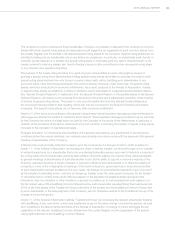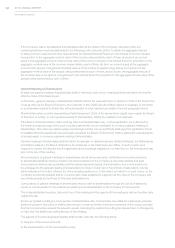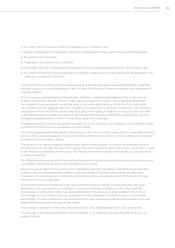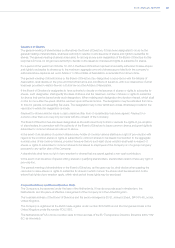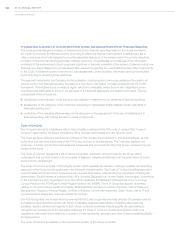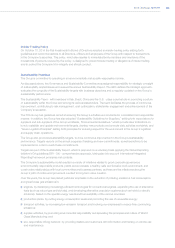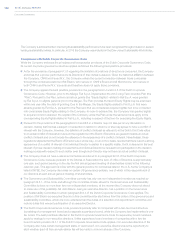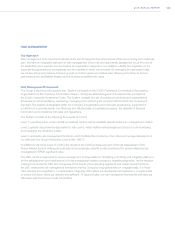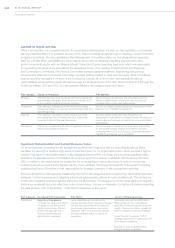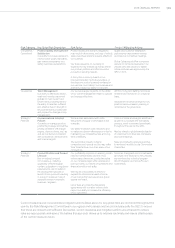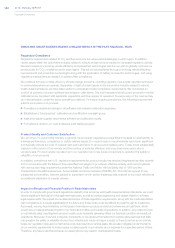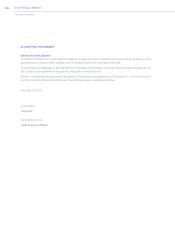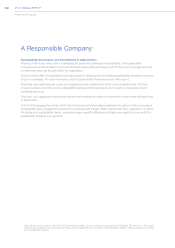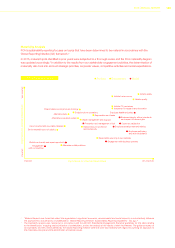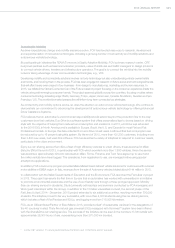Chrysler 2015 Annual Report Download - page 103
Download and view the complete annual report
Please find page 103 of the 2015 Chrysler annual report below. You can navigate through the pages in the report by either clicking on the pages listed below, or by using the keyword search tool below to find specific information within the annual report.
2015 | ANNUAL REPORT 103
Risk Category Key Global Risk Description Risk Factor Control / Mitigating Actions
Compliance /
Operational
Product Quality and Customer
Satisfaction
Our ability to produce vehicles to
meet product quality standards,
gain market acceptance and
satisfy customer expectations.
Product recalls and warranty obligations
may result in direct costs, and loss of vehicle
sales could have material adverse effects on
our business.
Our future depends on our ability to
expand into new markets as well as enrich
our product portfolio and offer innovative
products in existing markets.
A disruption or security breach in our
internal information technology system, or
the electronic control systems contained in
our vehicles, could disrupt our business and
adversely impact our ability to compete.
Quality and customer satisfaction
performance improvement metrics
monitored at Committee meetings.
Global Cybersecurity Plan to improve
security of connected systems in our
vehicles and add security to safety-
critical modules was approved by the
GPC in 2015.
Operational Talent Management
Our ability to effectively attract,
retain and develop personnel
globally to meet current and
future needs, including risks to
the ability to maintain sufficient
and effective bench strength in
key positions and properly plan
and prepare for changes in key
management.
Our success largely depends on the ability
of our current management team to operate
and manage effectively.
Attrition, hiring and staffing metrics are
reviewed and monitored on a regional
basis.
Assessment of bench strength for key
positions and succession planning is
monitored at the group level.
Strategic /
Financial
Commercial and Industrial
Policies
Our ability to manage product
positioning strategy (competitive
pricing consistent with margin
targets, discount levels, etc.) as
well as cost factors consistent
with competitors’ achievements
and internal targets.
We face risks associated with costs,
disruptions of supply or shortages of raw
materials.
Our ability to achieve cost reductions and
to realize production efficiencies is critical to
maintaining our competitiveness and long-
term profitability.
The automotive industry is highly
competitive and cyclical and we may suffer
from those factors more than some of our
competitors.
Control of costs and margins monitored
as part of our budget and forecasting
process, which is reviewed periodically
throughout the year by the GEC.
Metrics related to global standardization
of components to drive less complexity
and overall savings.
Sales and marketing (including pricing)
is monitored monthly by the Commercial
Committee.
Strategic /
Financial
Product Portfolio and Product
Lifecycle
Non or delayed renewal
of models (e.g., restyling,
upgrading of technological
content, adaptation to regulatory
requirements) due to delays in
the development process or
launch of new products resulting
in a drop in revenues / loss of
competitiveness in a specific
business / segment.
Our profitability depends on reaching certain
minimum vehicle sales volumes. If our
vehicle sales deteriorate, particularly sales
on our minivans, larger utility vehicles and
pick-up trucks, our results of operations and
financial condition will suffer.
We may be unsuccessful in efforts to
expand the international reach of some
of our brands that we believe have global
appeal and reach.
Labor laws and collective bargaining
agreements with our labor unions could
impact our ability to increase the efficiency
of our operations.
Technical, timing and cost commitments
(amongst other factors) for new vehicles
are monitored by individual program
at both Regional and Group Product
Committees.
Control measures and comprehensive mitigation actions listed above for key global risks are monitored throughout the
year by the Risk Management Committees in our regions and business sectors and subsequently the GEC to ensure
that these are relevant and sufficient. As needed, control measures and mitigation actions are enhanced to ensure
risks are appropriately addressed. We believe this approach allows us to address risk timely and ensure effectiveness
of the control measures taken.


